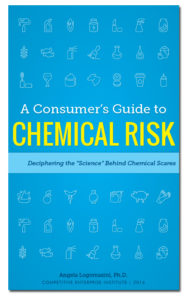Activists often suggest that if a chemical dangerous at high levels, its dangerous at low levels as well. But that’s not necessarily so. Traditionally, scientists have contended, “The dose makes the poison.” Indeed, many substances that are helpful or benign at low levels can sicken or kill at high levels. In addition, the duration of exposure matters as well.
For example, a 70-year-old individual who smoked a pack of cigarettes a day for 30 years has a much higher cancer risk than a 70-year-old who only smoked that much for a year or two in his 20s, all other factors being equal. Likewise, there is a big difference between intermittent trace exposures to a chemical among consumers and high-level, long-term exposures to that chemical among workers in an environment where the chemical is present at substantial levels. And the exposures to workers in the past may not even be relevant to workers today, as vastly improved workplace practices limit exposure to levels that are thousands of times lower.
Yet we often see headlines and websites suggesting any exposure level to certain chemicals is dangerousl. For example, the Environmental Working Group annually releases its “Shoppers Guide to Pesticides” sounding alarm bells about trace pesticides found on produce, despite the fact that the residue levels meet U.S. Environmental Protection Agency and Food and Drug Administration safety standards and are too low to have any public health significance. Yet headlines suggest these trace exposures matter thanks to EWG’s annual report.(1)
The claim that chemicals pose risks at any exposure level emerged in the latter part of the 20th century, when many researchers abandoned the idea that each chemical has a threshold exposure level below which risk is negligible. Those who abandoned the “threshold theory” contended that many chemicals can have adverse effects at any level and that risks increase linearly with any dose above zero. On the basis of those assumptions, regulatory policy around the world has focused on ways to regulate chemicals to reduce exposure to as close to zero as possible.
However, there is considerable evidence that the original research on linearity was fraudulent. Dr. Edward Calabrese of the University of Massachusetts documents how scientist Hermann J. Muller and his colleagues intentionally covered up research that contradicted Muller’s “discovery” of linearity, which had earned him a Nobel Prize. As Calabrese explains, Muller proclaimed in his Nobel Prize speech “that one could no longer consider the possibility of a threshold dose response for germ-cell mutagenicity,” yet he “made these public claims while knowing that the most extensive and relevant testing supported a threshold interpretation.”(2)
(1) For example, see Ashleigh Schmitz, “Meet the ‘Dirty Dozen’: Produce with the Most Pesticides,” FOX News, May 3, 2013, and “Which Foods Are Laced with Carcinogens? Now You Can Find Out,” The Daily Green, June 19, 2009, .
(2) Edward J. Calabrese, “How the US National Academy of Sciences Misled the World Community on cancer risk assessment: new findings challenge historical foundations of the linear dose response,”Archives of Toxicology (August 2013) 2013; DOI: 10.1007/s00204-013-1105-6.



[…] do not mean the chemical poses any risk in current uses and exposure levels. Remember, it’s the dose that makes the poison. And traces of chemicals in consumer products are too low to […]